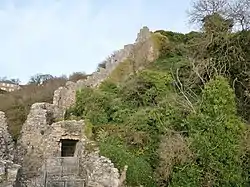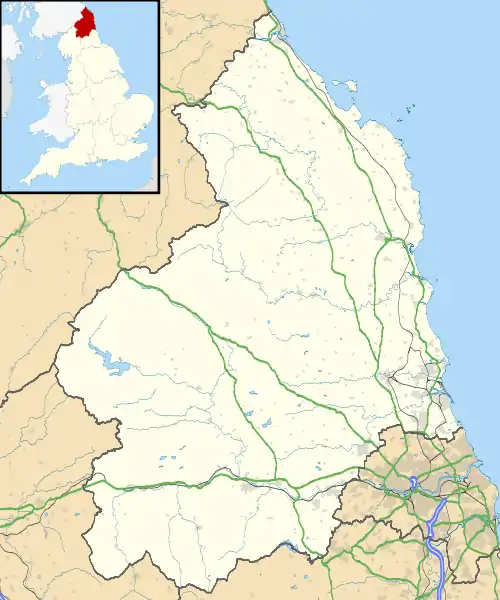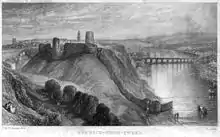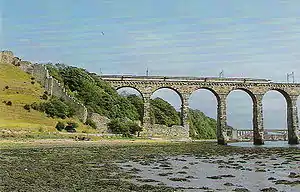Berwick Castle
Berwick Castle is a ruined castle in Berwick-upon-Tweed, Northumberland, England.
| Berwick Castle | |
|---|---|
| Berwick-upon-Tweed, Northumberland, England | |
 Berwick Castle 'Breakneck Path' and castle wall | |
 Berwick Castle | |
| Coordinates | 55.7738°N 2.0116°W |
| Grid reference | grid reference NT992535 |
| Type | Motte and bailey |
| Site information | |
| Owner | English Heritage |
| Open to the public | Yes |
| Condition | Ruined |
| Site history | |
| Materials | Stone |
| Events | Wars of Scottish Independence |
History


The castle was commissioned by the Scottish King David I in the 1120s.[1] It was taken by the English forces under the terms of the Treaty of Falaise in 1175[1] but then sold back to Scotland by the English King Richard I to fund the Third Crusade in around 1190.[1]
In November 1292, representatives of the English King Edward I arrived in Berwick and announced, in the great hall of the castle, King Edward's adjudication in favour of John Balliol of the dispute between him, Robert the Bruce and the count of Holland for the Crown of Scotland.[2] The castle was retaken by the forces of King Edward I in March 1296 during the First War of Scottish Independence.[3] However, the forces of Robert the Bruce recovered the castle for Scotland in April 1318.[1]
In 1330, "Domino Roberto de Lawedre" of the Bass, described as Custodian or Keeper of the Marches and the Castle of Berwick-upon-Tweed, received, apparently upon the termination of his employment there, £33.6s.8d, plus a similar amount, from the Scottish Exchequer.[4]
In 1464, the Exchequer Rolls of Scotland record that Robert Lauder of Edrington was paid £20 for repairs made to Berwick Castle.[5] The castle finally fell into English hands in the last week of August 1482: after invading Scotland following a pact with the Duke of Albany, Richard, Duke of Gloucester captured the castle from the 1st Lord Hailes.[6]
The castle was rendered obsolete by the construction of modern ramparts around Berwick during the reign of Elizabeth I in the late 16th century and it went into steady decline.[7] In August 1590 John Selby reported that a round tower used as the castle's only gun emplacement had collapsed in wet weather.[8] Large parts of the structure were simply used as a quarry (notably for the construction of the parish church, Holy Trinity during the Commonwealth).[9]
Governors, or keepers, of the castle
- Sir William Douglas, 1294–1296 surrendered to Edward I of England following the Massacre of Berwick
- Maurice de Berkeley, 2nd Baron Berkeley, English governor c.1314
- Edmond de Caillou, Gascon governor for the English, killed at the Battle of Skaithmuir 1316.
- Sir Robert de Lawedre of the Bass, 1330-3.[10][11]
- Patrick de Dunbar, 5th Earl of March, January-July 1333.[12]
- Robert de Lawedre of Edrington (later, "of the Bass"), 1461/2–1474.[13]
- David, Earl of Crawford, 1474–1478.
- Sir Robert Lauder of The Bass, Knt., 1478–1482.[14][15]
- Sir Patrick Hepburn, 1st Lord Hailes, 1482 (last Scottish governor).
- Sir William Drury (d.1579), Marshal of Berwick-upon-Tweed, before 1564.
- Francis Russell, 2nd Earl of Bedford, appointed 1564
- Sir George Bowes of Streatlam, County Durham (d. 1580), Marshal of Berwick, who, in 1568, escorted Mary, Queen of Scots, from Carlisle to Bolton Castle; Bowes' sister (Margery) married John Knox.
Popular Culture
The castle features in The Scottish Chiefs.[16]
Notes
- "Berwick Castle". Castles Forts Battles. Retrieved 10 November 2020.
- Dunbar, Sir Archibald H.,Bt., Scottish Kings – A Revised Chronology of Scottish History 1005–1625, Edinburgh, 1899: p. 116
- "Berwick Castle, Berwick upon Tweed, Northumberland". Historic England. Retrieved 10 November 2020.
- Stuart, John, LL.D., and Burnett, George, Lord Lyon King of Arms, The Exchequer Rolls of Scotland, vol. 1, 1264–1359, Edinburgh, 1878, pp. 279, 313, 339
- Scott, John, Berwick-upon-Tweed, The History of the Town and Guild, London, 1888
- Calendar State Papers Venice, vol. 1 (London, 1864), no. 483: Macdougall, Norman, James III (Edinburgh, 1982), pp. 169, 182.
- Historic England. "The medieval and post-medieval fortifications at Berwick upon Tweed (1015968)". National Heritage List for England. Retrieved 10 November 2020.
- Joseph Bain, Calendar of Border Papers, vol. 1 (London, 1894), pp. 365-6.
- "Our History". Berwick Parish Church. Retrieved 10 November 2020.
- Burnett, George, LL.D., Lord Lyon King of Arms, Exchequer Rolls of Scotland, vol.1, 1264-1359, Edinburgh, 1878, pps: 279,313,339 & 399.
- Berwick-upon-Tweed, the History of the Town and Guild, by John Scott, London, 1888, pps.248-9.
- Anderson, William, The Scottish Nation, Edinburgh, 1861, vol.iv, p.74.
- Burnett, 1884, vols.vii, pps: 145, 317, 400, 494, 578-9; 1885, vol.viii, p.118-8, 188, 456, 539, 551 and 633.
- The Great Seal of Scotland, charter no.1276 20 January 1477/8/
- Burnett, 1886, vol.ix, pps: 63/4. 81, 145 & 157.
- Porter, Jane (1921). The Scottish Chiefs. New York: Charles Scribner's Sons. p. 183-187. ISBN 9780684193403.
References
- Images of Berwick upon Tweed Castle
- The David & Charles Book of Castles, by Plantagenet Somerset Fry, David & Charles, 1980. ISBN 0-7153-7976-3
- The History of Scotland, by John Hill Burton, Edinburgh, 1874: vols: iv. p. 364–5, v. pps: 68, 71, 73, 115, 120, 257, and 365, for Sir William Drury
- John Knox, by Lord Eustace Percy, London, 1937, p. 165.
External links
- Official website
- Historic England. "Ruins of the Constable Tower (Part of Berwick Castle) (1371223)". National Heritage List for England.
- Historic England. "Berwick Castle (fragments, including towers and walls and steps) (1290213)". National Heritage List for England.
- Historic England. "Wall of Berwick Castle to north of the ruins of Constable Tower (1041696)". National Heritage List for England.
| Wikimedia Commons has media related to Berwick Castle. |
